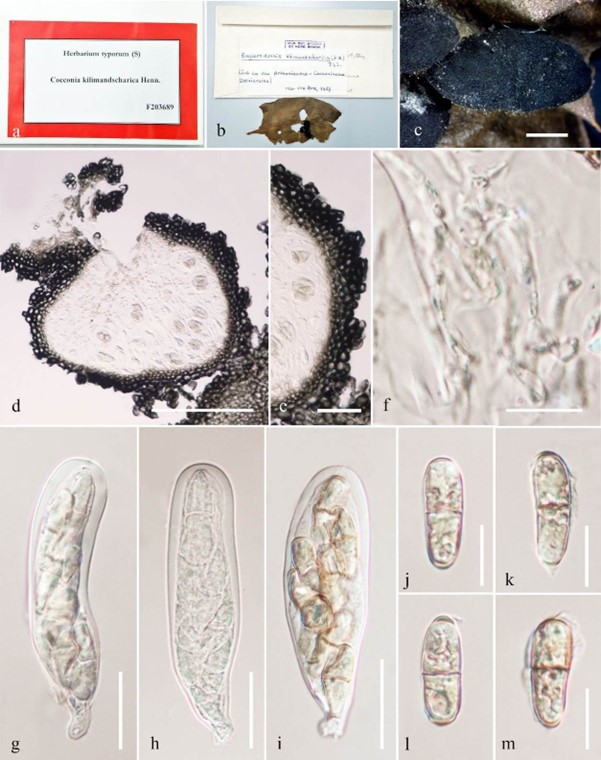Englerodothis kilimandscharica (Henn.) Theiss. & Syd., Annls mycol. 13(3/4): 285 (1915) Fig. 16
≡ Cocconia kilimandscharica Henn., in Engler, Pflanzenw. Ost-Afrikas Nachbarg., Teil C: 31 (1895)
MycoBank number: MB 150008; Index Fungorum number: IF 150008; Facesoffungi number: FoF 06240;
Biotrophic, pathogenic or saprobic on living and dead leaves of Mayepea gilgiana. Sexual morph: Stroma black, hard, subglobose to hemispherical, hypostromatic, multiloculate, strongly convoluted and forming an elaborate geometrical pattern externally, 7–8 mm in diam, the opposite upper surface of the leaf has sunken deeply in the extension of the stromata and has a dirty yellow discoloration, irregular in circumference, roundish, elongated or blister-shaped. Locules very numerous and dense, spherical. Individual stomatal elements up to 133–139 µm wide, 107–116 µm high, the tissues surrounding the locules made up of brown to dark brown pseudoparenchymatous tissue, lower region of base composed of small hyaline angular cells which tend to replace the cuticular lining of the leaf and penetrate between the distorted epidermal cells. Locules elongate the side wall, but merging with stromatal tissue, made up of dark brown angular cells with 1–2 paler inner layers, the apical part, flat, and dark brown, splitting at maturity to expose asci and interascal tissue. Interascal tissue of cellular pseudoparaphyses, copious, filamentous, each filament consisting of a chain of hyaline cells, the lower ones being compressed by the growing asci, the upper ones irregular in shape and reaching and becoming pigmented and surrounded by a copious gelatinous matrix. Asci 58–61 µm × 11–19 µm ( x = 59.5 × 16.7 µm, n = 10), 8-spored, cylindrical to cylindric-clavate, the apex broadly rounded, the base tapering abruptly to a short stalk, fairly thick-walled at all stages, thickest at the apex, fissitunicate, without an apical ring. Ascospores 15– 16 µm × 5–6 µm ( x = 16.3 × 6.0 µm, n = 10), arranged biseriately, 1-septate, slightly constricted at the septum, the upper cell with a rounded end, the lower one tapering, smooth and hyaline when young, pale brown at maturity. Asexual morph: Undetermined.
Material examined – AFRICA, Tanzania, Boma La Ng’ombe, Kilimanjaro, on living and dead leaves of Mayepea gilgiana (Oleaceae), 8 December 1893, G. Volkens, (S-F203689, holotype).
Economic significance – The genus Englerodothis is parasitic on living leaf blades petioles, and inflorescences and affect many hosts namely Mayepea gilgiana (Oleaceae) by air-borne ascospores. They are mainly reported from Africa, South of Sahara, Tanzania (Inacio & Minter 2000).

Figure 16 – Englerodothis kilimandscharica (S-F203689, holotype). a Details of herbarium material. b, c Habit and appearance of ascomata on host surface. d Section of ascoma. e Peridium. f Hamathecium. g–i Asci. j–m Ascospores. Scale bars: c = 2 mm, d = 30 µm, e, f, j–m = 10 µm, g–i = 20 µm.
